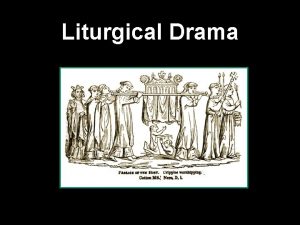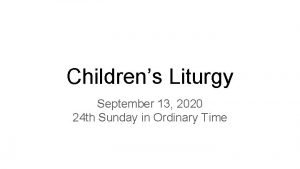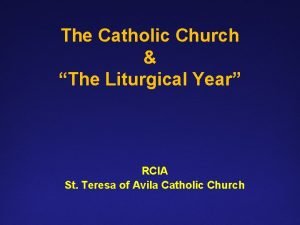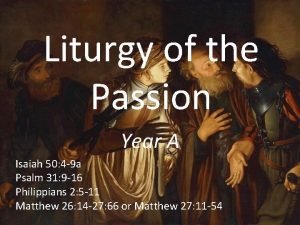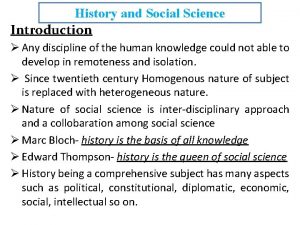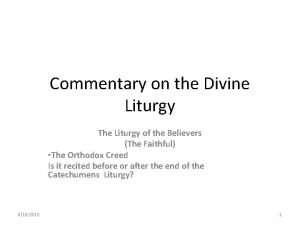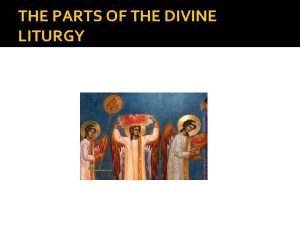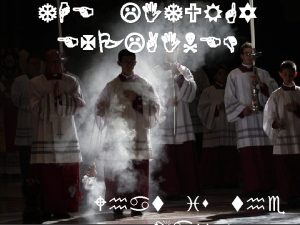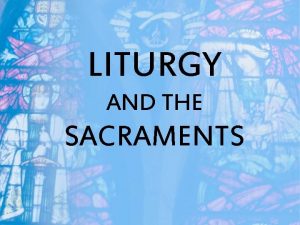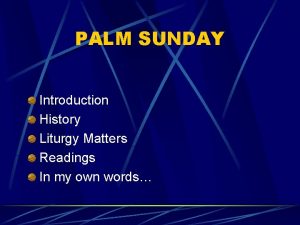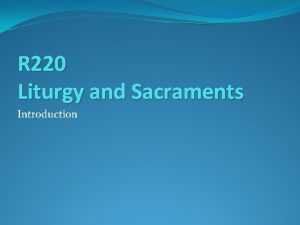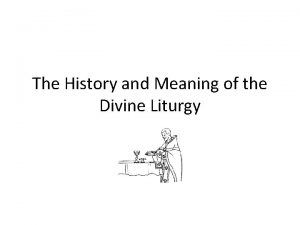The History of the Liturgy Introduction The Liturgy





























- Slides: 29

The History of the Liturgy

Introduction § The Liturgy and its rites were delivered by the Apostles to the churches, which they had established. The Apostles were taught by the Lord himself, who forty days, following His resurrection spoke to them “of the things pertain ing to the kingdom of God” (Acts 1: 3). § Saint Paul emphasizes this fact when he says, “For I have received of the Lord that which also I delivered unto you, that the Lord Jesus the same night in which He was betrayed took bread. . . ” (1 Cor 12: 23).

Documentation of the liturgy § In the beginning, the Liturgy was passed from the Apostles to their successors, the bishops as an oral tradition. This is the same way in which the books of the Bible were propagated. Oral tradition always preceded the written forms of both the Bible and the liturgies.

§ The Liturgy was commanded to writing only after heresies started to appear in the Church, and when heretics attempted to put their heretic teachings into the Liturgy. The fact that a manuscript of a liturgical text is dated to the fourth century, does not mean that the Liturgy was composed in the fourth century but merely that it was recorded in writing in the fourth century.

The Liturgy of Alexandria § Saint Mark, one of the seventy Apostles, who brought Christianity to Egypt around the middle of the first century A. D. , also brought to Egypt the liturgy that bears his name; The liturgy of Saint Mark. This liturgy which was originally written in Greek, is probably the oldest and most authentic liturgy in Christendom.

§ Saint John Chrysostom tells us that St. Mark was the first Apostle to inscribe the Liturgy, in the form of a service or a regular church ritual which is strictly followed in the celebration of the Eucharis. § This is not without Biblical foundation. We know that the very first Eucharist was held in the upper room, in St. Mark’s house in Jerusalem. The man carrying the pitcher of water is believed to be no other than St. Mark himself (Mk 14: 13_15).

The Liturgy of Rome § The earliest liturgy that is known to exist in the Church of Rome is the liturgy of Hippolytus. Most scholars agree now that this liturgy originated in Egypt and was exported to Rome.

§ The noted French Theologian Father Louis Bouyer says this about the origin of the liturgy of Hippolytus , “In any case it is a work of the third century and reflects if not the liturgical life of Rome, then that of Egypt and Alexandria. ”

The Liturgy of Jerusalem § In Jerusalem, the city of our Lord, the liturgy of St. James was the dominant Eucharistic prayer by the fourth century. Not only in Jerusalem, but also in Syria, Arabia, Greece and Armenia. § The liturgy is attributed to St. James, the brother of the Lord (the Lord’s cousin), who became the first bishop of Jerusalem. Hamman describes this liturgy: “Despite the hellenization of its form and of the thought beneath it, it is still astonish ingly close to the original Eucharist. ”

The Liturgy of Antioch § Antioch was the city in which Barnabas and Paul spent a whole year preaching and where the disciples were called Christians first. (Act 12: 25, 26). It was the first centre to be preached to outside Judea. In this important centre of Christianity, another liturgical tradi tion thrived by the fourth century: The liturgy of the Apostles. Supposedly written by Cle ment, bishop of Rome, who in turn received it from the Apostles.

THE LITURGY IN THE SIXTH CENTURY

The Church of Alexandria § The Greek liturgy of Saint Mark has now been translated into Coptic. Since the translation is traditionally attributed to Saint Cyril, it became known as: The liturgy of Saint Cyril. § Another anaphora known as the anaphora of Saint Basil was by now established side by side with the anaphora of Saint Cyril. It was believed that Saint Basil brought this anaphora with him from Cappadocia during his visit to Egypt in A. D. 357.

§ A third anaphora known as the anaphora of St. Gregory the Theologian started to make its ap pearance, first in the monasteries of. Nitria, and later in the rest of Egypt. Like the anaphora of St. Basil, which it resembles in many aspects, it is based on the ancient St. Mark's but reflects more Cappadocian influence. It starts with the Paulene grace formula, “The love of God the Father. . ”, so characteristic of the Cappadocian liturgy.

§ It is believed to be written by St. Gregory during his visit to Egypt as a young monk around the middle of the fourth century. The anaphora is addressed to Christ rather than to the Father. It abounds with the mature Theol ogy of the fourth century. The Christological and Sotiriological formulas are greatly expanded into what sounds like one of the sermons of St. Gregory the Theologian.

The Church of Rome § In Rome, the liturgy attributed to Pope Gregory the great, made its appearance in the sixth century and replaced the liturgy of Hip polytus, which has been in use before it. The liturgy of Gregory the Great is quite different from that of Hippolytus both in structure and in the treatment of its subjects. This led many to believe that it could have not evolved from the liturgy of Hippolytus.

§ Where then, did this liturgy attributed to Pope Gregory the great come from? Father Bouyer answers this intriguing question by saying, “Ultimately we have to start with the Alexandrian liturgy, . . . the liturgy of St. Mark, which had long been classical in Alexandria. ”

§ Father Bouyer gives several examples of this verbal parallelism, “Only in Egypt and Rome does the introductory dialogue begin with, ‘The Lord be with you’ followed by, ‘lift up your hearts’. ” A further point of similarity is the beginning of the Eucharist. At Rome it starts by, “It is truly meet and right, equitable and available to salvation. ” At Alexandria the same words are used. The Roman institution narrative mentions that Jesus “lifted up his eyes”—the same as in St. Mark's liturgy.

The Church of Constantinople § Towards the end of the fourth century, the liturgy commonly used in Constantinople was an expanded version of the Egyptian St. Basil's, almost twice its size § For some centuries, St. Basil was the principal liturgy of Constantinopole, until finally ousted by the liturgy attributed to St. John Chrysostom. The Byzantine St. Basil is still in use in the Eastern Orthodox churches but only ten times each year.

§ The liturgy of St. John Chrysostom which gradually replaced the Byzantine St. Basil's, may well be the form used in Antioch during Chrysostom's episcopate. It has much in com mon with the anaphora of the Apostles (see above) and at several points the wording is very similar to the Byzantine St. Basil's. It is a short anaphora, less than half the length of the Byzantine St. Basil.

THE LITURGY IN THE MIDDLE AGES § The middle ages saw a lot of dramatic changes, Rome broke up with Constantinopole in the eleventh century and the Protestants broke up with Rome in the sixteenth. The Liturgy deteriorated in the west until it finally “died”.

The “Silent” Mass § Around the eighth century, in both Rome and Constantinopole, it became fashionable to say most of the prayers of the Liturgy inaudibly. “It becomes certain that in the Frankish lands as at Rome, from the Sanctus on, the faithful could no longer hear what the priest was saying. ”

§ In Constantinopole, the Emperor had to intervene after receiving some complaints. The emperor then gave the following order, “Moreover, we order all bishops and priests to say the prayers used in the divine anaphora and holy baptism, not in audibly, but in a voice that can be heard by the faithful, so that the mind of those listening can be aroused to a greater compunction. ” The em peror threatened those who refused to carry on his orders.

The Invention of the Choir § Choral chants were introduced into the Liturgy and gradually overshadowed the role of the celebrating priests as well as that of the con gregation. The original liturgies had certain chants, but these were simple enough to be chanted by the whole assembly. Examples of these authentic chants include, the Sanctus, “Holy, Lord of Hosts. . . , ” and the people's “Amen” at certain parts of the Liturgy.

§ In Constantinopole, people started to introduce other chants that became more and more complex that they needed “specialists” to sing them. In due time, choirs took over the role of the con gregation. As the Choral chants grew in length they reduced the parts said aloud by the priest to a few sentences.

§ In Rome, things became even worse, the chants of the choir grew without any direct connection to the prayer of the priest. In the eleventh cen tury, the choir sang throughout the Liturgy, songs that had no relationship to the mass. “It may be said that the priest had become so enshrouded in the silence of the canon that in the eyes of the faithful he appeared to vanish within it. ”

The Liturgy in Egypt § The Egyptians, ostracized by both Rome and Constantinopole, and trying to cope with the eccentricity and outright persecution of the various ruling dynasties, were spared the tragic changes that happened elsewhere. In their pre_ occupation with survival in a hostile surround ing, the Copts clung to their Eucharistic tradition.

§ In doing so, the Copts did the whole of Christendom a great service, by preserving for them an authentic Eucharistic and liturgical tradition. It is that led many researchers including Leitzman and Richardson to the conclusion that : § The authentic Eucharistic and liturgical tradition as delivered by the Lord to His disciples, and as was practiced by the disciples after the Lord's ascension is found only in Egypt.

THE LITURGY IN THE TWENTIETH CENTURY § Cullman, a professor in the faculty of Protestant Theology in Paris, studied in detail the worship in the early Church and came to the conclusion: § “We must assert here and now that the services of worship in the Protestant Churches of our own era are very much poorer, not only in the free working of the Spirit, but also in respect of what is liturgical. ”

§ The twentieth century has witnessed a 'liturgic movement' in most churches_ Orthodox, Catholic and Protestant. Thanks to this movement, the churches have revised or completely changed their liturgies in order to conform to the liturgy of the early Church; also they changed their practices in favour of more participation of the faithful in the liturgy and more frequent communions.
 Liturgy of.the word
Liturgy of.the word Four parts of liturgy
Four parts of liturgy What are liturgical dramas?
What are liturgical dramas? Catholic children's liturgy worksheets
Catholic children's liturgy worksheets Ritual of the secular franciscan order
Ritual of the secular franciscan order 000yearold holy mystery
000yearold holy mystery What is liturgy
What is liturgy Also history physical
Also history physical History as a social science discipline
History as a social science discipline Introduction to history of education
Introduction to history of education What does salvation history mean
What does salvation history mean Hình ảnh bộ gõ cơ thể búng tay
Hình ảnh bộ gõ cơ thể búng tay Lp html
Lp html Bổ thể
Bổ thể Tỉ lệ cơ thể trẻ em
Tỉ lệ cơ thể trẻ em Gấu đi như thế nào
Gấu đi như thế nào Tư thế worms-breton
Tư thế worms-breton Hát lên người ơi alleluia
Hát lên người ơi alleluia Các môn thể thao bắt đầu bằng tiếng bóng
Các môn thể thao bắt đầu bằng tiếng bóng Thế nào là hệ số cao nhất
Thế nào là hệ số cao nhất Các châu lục và đại dương trên thế giới
Các châu lục và đại dương trên thế giới Công của trọng lực
Công của trọng lực Trời xanh đây là của chúng ta thể thơ
Trời xanh đây là của chúng ta thể thơ Mật thư tọa độ 5x5
Mật thư tọa độ 5x5 101012 bằng
101012 bằng Phản ứng thế ankan
Phản ứng thế ankan Các châu lục và đại dương trên thế giới
Các châu lục và đại dương trên thế giới Thể thơ truyền thống
Thể thơ truyền thống Quá trình desamine hóa có thể tạo ra
Quá trình desamine hóa có thể tạo ra Một số thể thơ truyền thống
Một số thể thơ truyền thống


